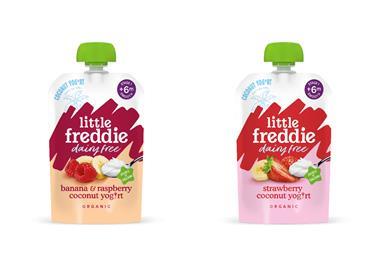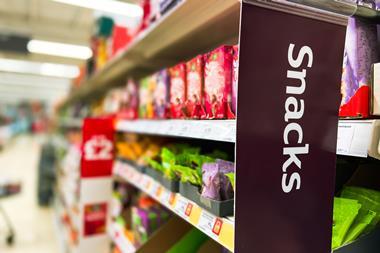UK, French and German consumers are as one when it comes to the causes of the obesity crisis - but views vary on the solutions. Julian Hunt reports on exclusive new research for The Grocer
European food cultures may vary wildly as you move around the EU, but consumers in its three largest economies are suprisingly as one when it comes to the key issue in the food and health debate, namely: who is to blame? That’s one of the main findings of a groundbreaking survey conducted for The Grocer by HI Europe.
The market research company polled over 6,000 consumers across the UK, France and Germany. And it found that consumers overwhelmingly blame themselves for Europe’s problems with poor diets and growing obesity.
Manufacturers take some flak, as do supermarkets. But the media is also identified as being partly to blame - suggesting, perhaps, that consumers believe the EU’s obesity crisis has as much to do with scaremongering as fact.
That view is supported by the fact that respondents in all three countries believe the media should take more responsibility for helping people to eat more healthily - along with consumers, manufacturers, health experts, regulators and government.
This emphatic response will be music to the ears of the food and drink industry in this country, which has long argued for the government to realise that tackling obesity needs all stakeholders to work together to find solutions to the problem.
The research also throws up some more good news for the industry.
HI Europe first asked these questions of UK consumers back in May this year. And what’s fascinating is that their view that consumers need to take responsibility for their diets has hardly changed - despite the
massive amount of coverage the obesity issue has received in this country since the summer and, of course, since the Public Health White Paper was unveiled last month.
But while consumers in the UK, France and Germany share similar views on the question of who is to blame for the obesity crisis, the research suggests that attitudes do vary enormously across the EU on other issues - particularly nutrition labelling.
The results of our research are highly significant, if only because the government in this country has decided to put labelling at the heart of its strategy for improving the health of the nation.
It has told the food and drink industry to agree voluntarily to introduce a new signposting system on foods by 2006 or face the prospect of legislation.
New legislation would be impossible, of course, without some form of EU--wide agreement. So the government plans to make this issue a priority next year, as its White Paper explains: “We will press vigorously for progress before and during the UK presidency of the EU in 2005 to simplify nutrition labelling and make it mandatory on packaged foods.”
In light of that intention, however, our new research from HI Europe raises some interesting questions.
On the one hand it would seem to support the government’s decision to launch a crusade for better labelling.
As Caroline North, of HI Europe, explains: “It is hugely important that consumers are given the proper tools to get the most out of the nutritional information that is presented to them, otherwise how else can they make informed decisions and change their eating habits? In France alone, more than 60% of respondents said they found the nutritional information on food and drink packaging difficult to understand.”
But on the other hand, the research shows that it would be very difficult to develop any EU directive for a single labelling scheme that would be useful for all consumers.
As the research shows, those in the UK are far more likely than their French or German cousins to read such labels in the first place. And it’s clear from the research that the French and Germans have a much more relaxed attitude to the food and drink they are buying and consuming.
“There would clearly be some interesting challenges ahead for the EU in introducing unified labelling controls,” says North. “Not surprisingly the UK, France and Germany have different preferences even when it comes to presenting the information.”
She adds: “In fact, in some cases their needs differ so greatly that it raises questions as to whether a generic model is feasible. The UK would rather have ‘per pack’ labelling, France would rather have ‘per serving/portion’ while Germany would rather see ‘per 100g/100ml’.”
When it comes to food labelling, then, it’s very much a case of vive la difference!
European food cultures may vary wildly as you move around the EU, but consumers in its three largest economies are suprisingly as one when it comes to the key issue in the food and health debate, namely: who is to blame? That’s one of the main findings of a groundbreaking survey conducted for The Grocer by HI Europe.
The market research company polled over 6,000 consumers across the UK, France and Germany. And it found that consumers overwhelmingly blame themselves for Europe’s problems with poor diets and growing obesity.
Manufacturers take some flak, as do supermarkets. But the media is also identified as being partly to blame - suggesting, perhaps, that consumers believe the EU’s obesity crisis has as much to do with scaremongering as fact.
That view is supported by the fact that respondents in all three countries believe the media should take more responsibility for helping people to eat more healthily - along with consumers, manufacturers, health experts, regulators and government.
This emphatic response will be music to the ears of the food and drink industry in this country, which has long argued for the government to realise that tackling obesity needs all stakeholders to work together to find solutions to the problem.
The research also throws up some more good news for the industry.
HI Europe first asked these questions of UK consumers back in May this year. And what’s fascinating is that their view that consumers need to take responsibility for their diets has hardly changed - despite the
massive amount of coverage the obesity issue has received in this country since the summer and, of course, since the Public Health White Paper was unveiled last month.
But while consumers in the UK, France and Germany share similar views on the question of who is to blame for the obesity crisis, the research suggests that attitudes do vary enormously across the EU on other issues - particularly nutrition labelling.
The results of our research are highly significant, if only because the government in this country has decided to put labelling at the heart of its strategy for improving the health of the nation.
It has told the food and drink industry to agree voluntarily to introduce a new signposting system on foods by 2006 or face the prospect of legislation.
New legislation would be impossible, of course, without some form of EU--wide agreement. So the government plans to make this issue a priority next year, as its White Paper explains: “We will press vigorously for progress before and during the UK presidency of the EU in 2005 to simplify nutrition labelling and make it mandatory on packaged foods.”
In light of that intention, however, our new research from HI Europe raises some interesting questions.
On the one hand it would seem to support the government’s decision to launch a crusade for better labelling.
As Caroline North, of HI Europe, explains: “It is hugely important that consumers are given the proper tools to get the most out of the nutritional information that is presented to them, otherwise how else can they make informed decisions and change their eating habits? In France alone, more than 60% of respondents said they found the nutritional information on food and drink packaging difficult to understand.”
But on the other hand, the research shows that it would be very difficult to develop any EU directive for a single labelling scheme that would be useful for all consumers.
As the research shows, those in the UK are far more likely than their French or German cousins to read such labels in the first place. And it’s clear from the research that the French and Germans have a much more relaxed attitude to the food and drink they are buying and consuming.
“There would clearly be some interesting challenges ahead for the EU in introducing unified labelling controls,” says North. “Not surprisingly the UK, France and Germany have different preferences even when it comes to presenting the information.”
She adds: “In fact, in some cases their needs differ so greatly that it raises questions as to whether a generic model is feasible. The UK would rather have ‘per pack’ labelling, France would rather have ‘per serving/portion’ while Germany would rather see ‘per 100g/100ml’.”
When it comes to food labelling, then, it’s very much a case of vive la difference!


















No comments yet